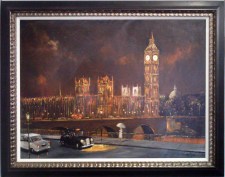Corrigan, Cavan

Cavan Corrigan was born in Barnard Castle, a small market town in north-east England, and from an early age, his principal interests were drawing and painting. After going to the Saturday matinees at the local cinema, he would go home and draw the action scenes of the cowboys and horses that he had just seen on the screen. By the age of seven, he was sent by his parents to the local art school. His teacher was Douglas Pittuck, a renowned artist with paintings in the Queen's collection.
Under Pittucks's tutelage, Corrigan learned draftsmanship and perspective. He continued to study with Pittuck until the age of eighteen, when he entered the Fine Art school at Durham University. Here Corrigan excelled in life drawing, and figures have remained a vital part of his work ever since.
Earning an honors degree in Fine Art, Corrigan moved in 1964 to the midlands to take up an Art lecturing post. He married and had a son, and together they vacationed frequently in Spain and France, where he found inspiration in both countries, particularly the gypsy festivals of the Camargue in southern France.
After twelve years of teaching, Corrigan wanted only to paint. Since it was not possible to do both jobs successfully, he decided to teach only part-time, while making painting his priority.
He joined a local family circus, and held exhibitions under the Big Top, painting clowns, tightrope walkers, acrobats, and other circus performers.
Initially working in portraiture with charcoal and a sketchpad around the tables of a busy theatrical restaurant in Birmingham, he sold his paintings right off the walls. This period of his life lasted for eight years, receiving major commissions for portraits of entertainment celebrities in the UK. He also completed larger commissions in the form of murals for bars, restaurants, hotels and stately homes.
A variety of influences have shaped his work, including the drama of post-war films, the circus, the stage, the cities and landscapes of Europe, the spontaneity of the Impressionists, the action of the Camargue…. ideas mix and blend. He finds that inspiration is everywhere, even in the drollness of everyday life there is something quirky or humorous worth capturing.
Corrigan has recently entered the American art scene, and he is presently working on new ideas inspired by American history and culture.